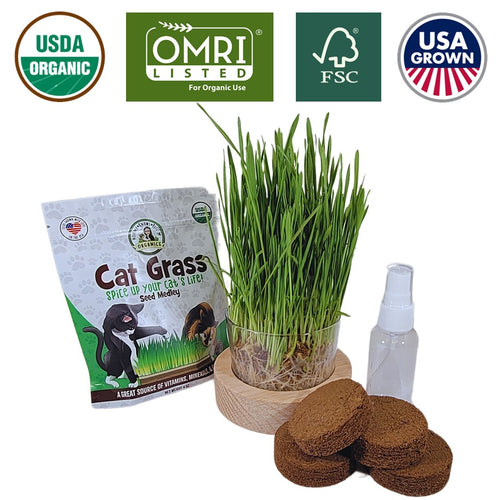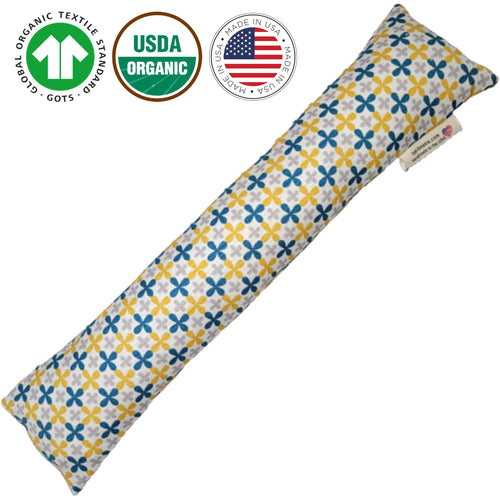Your Cart is Empty
Free 2-5 day delivery | No minimum purchase required
Free 2-5 day delivery | No minimum purchase required
Shop
Learn
FAQ: Which Countries Allow You to Travel with Your Cat?
 by K Marie Alto Updated
8 min read
by K Marie Alto Updated
8 min read

Dogs are frequently our travel companions, but it's relatively rare to bring cats with us, at least on shorter-term trips. A brief vacation is nothing; half the time, it feels like our furry feline friends don't even notice we're gone as long as they're still fed at the right time each day. Dogs aren't nearly as independent and can get into a lot of trouble while we're gone, which is why we either board them, hire a sitter, or bring them with us.
For longer trips, though, cats need to be cared for. You might be able to leave your fur baby with a friend or family member for a few weeks or months while you travel, but sometimes, that option just isn't available. If you're going abroad for a significant length of time – teaching ESL in another country, moving for a job, caring for family in another nation for an extended time, or whatever other reason brings you across the border – you may want to figure out how to bring your cat.
If you're looking for the same sort of information but for your dog instead, check out this guide I wrote. While a lot of the information is the same across both of these, there are some unique peculiarities between species you'll want to know.
Table of Contents
- Can You Travel Internationally with Your Cat?
- Can You Travel to Another Country with a FIV+ Cat?
- How Do You Find the Rules for International Travel with a Cat?
- What Information and Supplies Do You Need to Travel Internationally with Your Cat?
- Are There Other Details to Know About Traveling Internationally with Your Cat?
Can You Travel Internationally with Your Cat?
This is a surprisingly tricky question to answer. The fact is, every country in the world is able to set its own rules and laws. Some of them don't let you travel to them at all, some prohibit bringing pets of any sort into the country, some have restrictions on the types and breeds of pets you can bring in, and some are completely open to any companion you're taking with you.

It's also important to keep in mind that coming back to the USA has its own requirements. Most of the time, if you have everything you need to travel out of the country, you'll have everything you need to come back, but you should still take the time to double-check before your return trip.
Can You Travel to Another Country with a FIV+ Cat?
FIV, or feline immunodeficiency virus, is generally more well-controlled than some other pet-borne diseases like rabies. As such, most countries don't restrict cats with FIV. You'll need to have an appropriate health certificate, vaccination records, and possibly lab test results, but you won't be outright prohibited, at least as far as I know. If you know of a country that does prohibit FIV+ cats, let me know in the comments!

One thing to keep in mind, though, is that FIV makes your cat more susceptible to infections and diseases, and when you travel, you risk picking up something that isn't local to you (obviously). The stress of a flight, the need to be shipped along with other animals, and the new germ profile of wherever you land might put your fur baby at risk. It's often a good idea to find a place for your FIV+ kitty to live back home while you travel, as much as you might want to bring them with you.
How Do You Find the Rules for International Travel with a Cat?
Every country is allowed to set its own rules for importing pets, which means you need to be able to find those rules so you can follow them. For example, you may need a valid international pet health certificate, you may need to apply to bring your cat with you in advance, and there may be specific limitations on certain kinds of pets. With cats, you're probably fine as far as breed restrictions go, though you may have issues if you have an exotic breed like a serval, caracal, or other larger semi-wild cat breeds. Dogs tend to have more breed-based travel restrictions than cats.
There are a few ways you can find the information necessary to travel with your cat to another country. One of the easiest is to find that country's embassy information. Most countries have a foreign embassy in Washington D.C. and have information on contacting them that is publicly available on this page. By calling, emailing, or otherwise reaching out to them, you can learn their restrictions on pets.
Another option is to visit the USDA's Animal and Plant Health Inspection Service page, which lists various countries and their pet travel requirements. There are also frequently websites for those individual country governments you can check as well.

What if you're traveling to multiple countries in a single trip?
If you plan to, for example, fly into a country in Southeast Asia and then travel throughout the region from country to country, staying in different places for just a month or two at a time, then you'll have to contend with a wide range of different regulations.
If you're traveling to one country and back, you only need to know that country's restrictions. If you're traveling between foreign nations before returning home, you'll need to know the restrictions on each nation. You don't want to get halfway through a trip and find one particular country that prohibits your cat from entering, right?
Sometimes, this is easy. The European Union largely has one set of codified rules for most of its member nations. Other countries stipulate their own rules, and it can be a mess to deal with. You also might have different restrictions depending on whether you're driving across the borders with your cat or flying internationally with your cat.
What Information and Supplies Do You Need to Travel Internationally with Your Cat?
There's a lot you'll need before you can travel to another country with your cat.
Get a USDA-Endorsed pet health certificate.
A pet health certificate is just a piece of paperwork that says your pet is in good health and is up to date on their vaccinations. Most of the time, your vet can give you this certificate quickly and easily.
A USDA-endorsed pet health certificate is a little more complicated. It's the same paperwork, but you can only get it from a USDA-endorsed veterinarian. It generally costs a fee to get your certificate endorsed. This certificate is frequently required as an internationally-recognized standard for validation.
Obviously, your cat needs to be in good health and updated on their vaccinations in order to get this certificate. The last thing you want is to commit an international crime by lying about your cat's health! Rabies vaccinations are extra important in particular, so make sure your cat is boosted as necessary before you travel.
The USDA has a whole page dedicated to this paperwork and an office you can call to ask any questions you may have, so check it out here.
Some places have alternative options you can investigate. For example, the EU has a Pet Passport system. It's rather similar to the USDA health certificate but is broadly recognized and available throughout the EU. If your trip involves numerous EU countries, getting one of these pet passports might be a good idea.

Get an ISO-certified microchip.
The International Organization for Standardization is the global organization responsible for setting standards for all sorts of things, including technology. Two standards – ISO 11784 and ISO 11785 – are relevant to microchips for pets. They outline things like how the chip needs to be made, and what kind of data, in what formats, it should contain.
You don't need to know what the standards are, but you probably do need to make sure your cat has an ISO-certified microchip. That way, if the worst happens and your fur baby escapes while you're traveling, local vets can scan for a valid chip with information they can read and can find you. Obviously, make sure it has relevant information on it that the vet can use to contact you.
There are a lot of quirks to how microchip numbers and standards are handled, and what databases they connect to, so you might want to familiarize yourself with them, or at least the type and brand of chip your cat has, before you travel.
Check applications, approvals, and timelines.
Some countries essentially let you bring a cat along and just review your documentation at customs. Others require advance approval and an application process you need to have submitted well in advance. This process can take months, so make sure you do your research well in advance of when you're planning to bring your cat to the country with you and have all of your paperwork squared away.
Are There Other Details to Know About Traveling Internationally with Your Cat?
Of course. There will always be more details, so I'll cover everything I can to try to help you travel more smoothly.
Make sure to scout your accommodations ahead of time. With dogs, you have to worry about things like dog parks nearby, how dog-friendly the local establishments are, and so on. Cats don't have the same needs, but you do need to make sure any place you're staying, for short term or long term, allows your cat. You don't want to show up at a hotel, condo, or apartment only to find your cat isn't allowed, right?
Have your accessories ready to go. There's a lot you might want to make sure you have to make travel a smoother experience.
- A sturdy, breathable carrier for your cat while they're being moved throughout airports, planes, and accommodations.
- A collar that is easy to remove for airport security if necessary and reliable enough to stay in place around an anxious kitty.
- A harness, for times when your cat needs to be out of the carrier but still controlled. Make sure you spend some time getting them used to it in advance!
- Folding or collapsible bowls for food and water. Especially for very long flights, you'll probably need to give your fur baby some nourishment.
- A portable litter box and sealable bags. You may not be able to dispose of your cat's waste on a plane, so some backup to secure it without making the flight unpleasant for everyone is a good idea.
Consider the availability of food and medicine. This is especially relevant if your cat is on a special diet for health reasons; you may not be able to find the right kinds of foods or even certain medications where you're traveling. Unfortunately, some places around the world don't give as much consideration or care to cats. You might also want to make sure you have a vet lined up in advance in case something happens. You want to know where to go in an emergency, after all.

Pay attention to the flight planning itself. I have a whole guide on flying with a cat, so check that out and plan ahead. Chances are, if your cat is too big, if you have more than one cat, or if you're on certain airlines, you may not be allowed to bring your cat with you in the cabin, and they may need to fly cargo. Make sure you're planning ahead!
One detail is that some vets might recommend anxiety medications before a flight, especially if it's a longer flight. However, some airlines might prohibit sedating or medicating a pet before a flight because it can become a health risk. Double-check the details.
Give them plenty of time to acclimate to their new environs. Cats are creatures of routine, habit, and stability. Once you arrive at your destination, they will probably find the smallest, darkest space they can to hide in for a while until they feel more comfortable. It can take them days or even weeks to get used to their new home, so make sure to give them that space and time.
If all goes well, you'll have a comforting friend in a new living situation, and you'll only need to repeat the process when you return. Hopefully, all goes well for you! If you have additional advice or perspective, or if you have questions I missed, let me know in the comments as well.
K Marie Alto
K. Marie is an animal lover, wife, kitty mom, dog auntie, writer, and co-founder of Toe Beans, a proud American family-owned online boutique pet supplies store focused on the improvement of the life of furry family members via pet parent education, better products, and advocacy. She has over 20 years of experience as a pet momma. She loves sharing her personal journey and experience as a pet parent via her blog and Facebook page where she currently has more than 50K followers (@furrytoebeans) and counting :-). Read more
Leave a comment
Comments will be approved before showing up.
Also in Pet Parents Blog by Toe Beans

Techniques To Stop Your Cat from Begging While Eating
by K Marie Alto April 10, 2025 10 min read
Learn how to manage your cat's begging behavior during meal times with effective techniques that enhance comfort and ensure their safety, as well as yours.

The Truth Behind Zeus, The World’s Largest Great Dane
by K Marie Alto April 03, 2025 10 min read
Learn about Zeus, a gentle giant and therapy dog who holds the record as the world’s tallest Great Dane, showcasing his lovable nature and impressive stature.

Bengal Cat Guide: History, Health, and Personality Traits
by K Marie Alto March 27, 2025 9 min read 2 Comments
Learn about the Bengal cat with our guide, covering their history, health, and personality traits to help you decide if this striking breed is right for you.
Related Products

Cat Grass Growing Kit | Starter | USDA Organic Seeds | Grown in the USA
$25.99

Cat Kicker Toy | Organic | Handmade in the USA
$19.95

Cat Beds | Customizable Cat Caves
$29.99
Recent Articles
- Techniques To Stop Your Cat from Begging While Eating April 10, 2025
- The Truth Behind Zeus, The World’s Largest Great Dane April 03, 2025
- Bengal Cat Guide: History, Health, and Personality Traits March 27, 2025
- How Can You Stop Your Dog from Licking Their Paws? March 20, 2025
- Why You Should Invest in Automatic Pet Water Fountains March 13, 2025
- Guide: The Ultimate List of Fruits That Your Dog Can't Eat March 06, 2025
- Is Your Cat in Heat? The Signs and What You Should Know February 27, 2025
- Dog Spay Surgery: What Symptoms Can You Expect After? February 19, 2025
- DIY Tips for Making Healthy Homemade Cat Food Recipes February 13, 2025
- 10 Tips for Training Blind Dogs from Expert Trainers February 06, 2025
